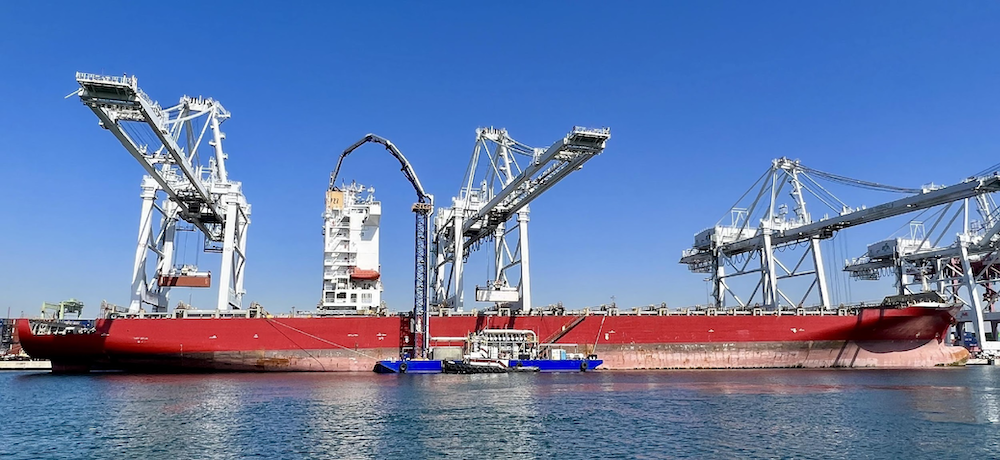California based Aeras brings emissions capture technology to ships at Los Angeles & Long Beach
On December 4, 2023, a barge-based emissions capture technology, developed by California-based AERAS, was certified by the California Air Resources Board (“CARB”) to begin offering “commercial emission capture and control services for ships at berth” at the Ports of Los Angeles and Long Beach.
In an announcement, AERAS explained that its barge transporting “emissions capture and control” technology “attaches directly to the ship when it is at berth and directly extracts and treats its emissions … The system requires no physical modifications to vessels, it is available in locations where shore power is not available, or where the shore power systems are impacted by moisture, mechanical issues, or require maintenance.”
The technology was developed in accordance with CARB’s ‘Ocean-Going Vessel At-Berth Regulation.’

Contracts In Place
In an interview with AJOT, Clay Sandidge, CEO of AERAS, explained: “We have contracts, pretty much contracts in place for full utilization of that unit and our problem is we only have one unit … so we can only operate on one ship at a time. Our major push right now is to start construction on units two, three, and four. And we anticipate doing that here imminently. I'm certain we'll get started on construction this first quarter of this year and have at least four units operational by the first quarter of 2025.”
Companies that have contracted with the service include Maersk and CMA/CGM.
He added that a contract is being negotiated with Matson: “We are also working on contracts with Pasha right now … and with a couple of smaller carriers including Swire. This week we go on one of Matson's vessels, and then later this month we've got a CMA ship and another Matson vessel. And then we're filling up our dance card for February. Right now (it) looks like we'll be on at least one Maersk ship. And one CMA vessel and probably three Matson vessels that are in rotation … We've got at least three ship calls per month with Matson.”
The new California emission rules will also be impacting tankers, roll on/roll off (Ro/Ro) vessels and bulk carriers so AERAS is working with these other carriers: “We have gotten letters of intent to do demonstrations on several Ro/Ros including letters of intent from NYK Lines and Wallenius Wilhelmsen Lines … We're also … working with several of the major oil companies to demonstrate on tankers … including Phillips 66 and Shell.”
As soon as the “Coast Guard releases … the vessel, we go onto that vessel. We're operating within about 15 minutes of being released … We operate for 36 hours on the average per vessel although some are for longer and some for less.”
The Emissions Capture System
Sandidge described the processes of emission capture as follows: “Diesel exhaust enters the system from a boom mounted minimal-loss coupling. Particulates are removed by an array of 10 self-cleaning Diesel Particulates Filters. The system recycles heat energy via an in-line heat exchanger. Process gas is heated to optimal temperature, treated with ammonia, and processed in a dual chamber SCR catalytic system that removes over 90% of NOx (nitrogen oxides).
Cleansed air is released with over 90% of emissions removed.
[And] at the conclusion of the process: “… the only waste stream that we have coming out of our system is a little bit of carbon soot that we pull out of our diesel particulate filters.”
AERAS and Carbon Capture Technology
AERAS is now working on an added technology to capture carbon emissions, Sandidge said, “We are looking at a potential carbon capture treatment … at the end of our unit. We anticipate demonstrating that with USC (University of Southern California) and UCLA (University of California Los Angeles) later this year. The cost, the add-on cost for a carbon capture system would be about one million dollars. It would add … $50 an hour roughly to capture the carbon. That is not part of our treatment today, but we're looking at that for the future … The shipping lines want it because they can say they're capturing carbon at birth. We're not there yet … but we anticipate by 2025, we probably will get there.”
American & California Built
Sandidge said the units will each cost about $8 million and will be built in Southern California with California labor and parts that are predominantly U.S. made: “That's another absolute beautiful thing we want to highlight … we are using all local labor … in Southern California, and basically in Wilmington, San Pedro, and Long Beach. We are utilizing companies that are well established. … We anticipate hiring between 20 and ... 60 people to build these vessels … And then operationally, we’re hiring labor, local labor and we're about 99% … American built [parts].”
© Copyright 1999–2024 American Journal of Transportation. All Rights Reserved

